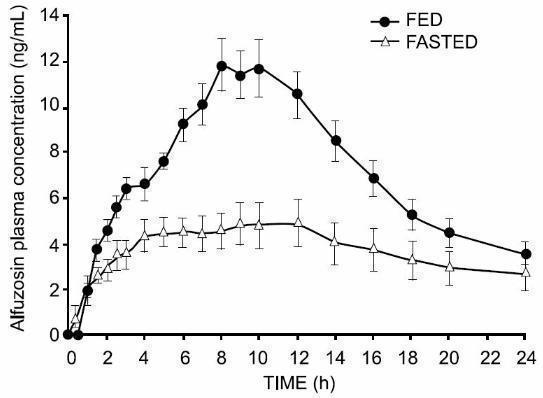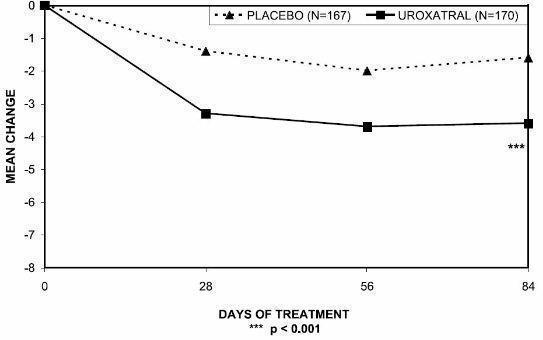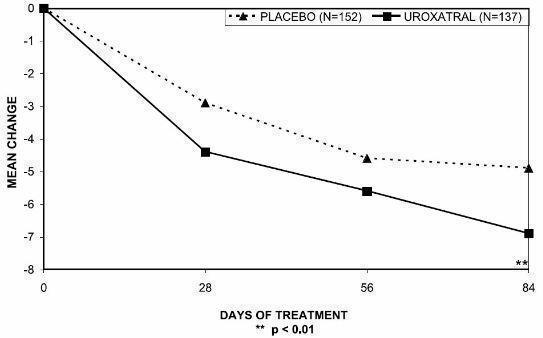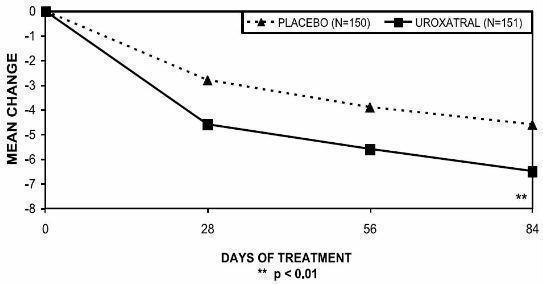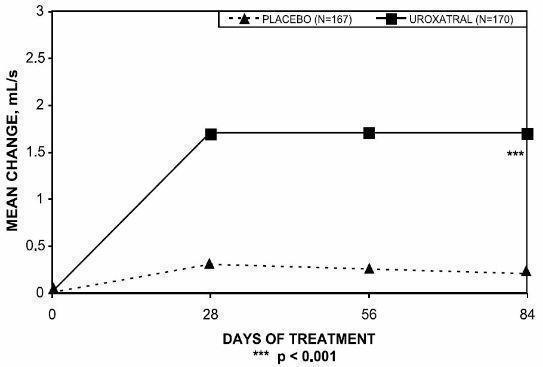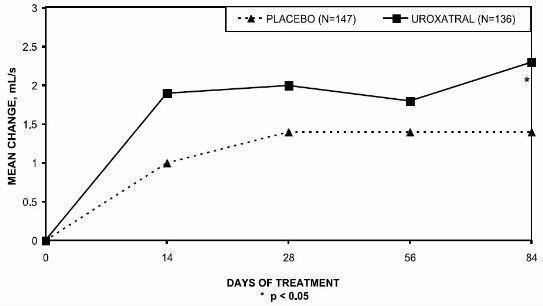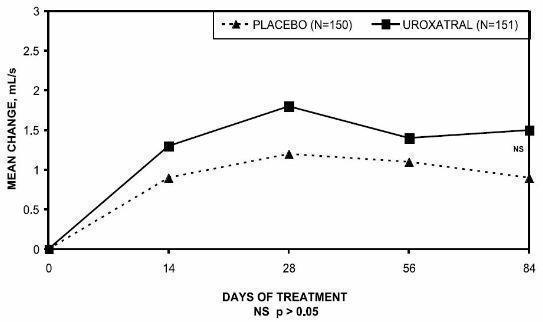UROXATRAL Extended-release tablet Ref.[49799] Active ingredients: Alfuzosin
Source: FDA, National Drug Code (US) Revision Year: 2021
12.1. Mechanism of Action
Alfuzosin is a selective antagonist of post-synaptic alpha1-adrenoreceptors, which are located in the prostate, bladder base, bladder neck, prostatic capsule, and prostatic urethra.
12.2. Pharmacodynamics
Alfuzosin exhibits selectivity for alpha adrenergic receptors in the lower urinary tract. Blockade of these adrenoreceptors can cause smooth muscle in the bladder neck and prostate to relax, resulting in an improvement in urine flow and a reduction in symptoms of BPH.
Cardiac Electrophysiology
The effect of 10 mg and 40 mg alfuzosin on QT interval was evaluated in a double-blind, randomized, placebo and active-controlled (moxifloxacin 400 mg), 4-way crossover single dose study in 45 healthy white male subjects aged 19 to 45 years. The QT interval was measured at the time of peak alfuzosin plasma concentrations. The 40 mg dose of alfuzosin was chosen because this dose achieves higher blood levels than those achieved with the co-administration of UROXATRAL and ketoconazole 400 mg. Table 3 summarizes the effect on uncorrected QT and mean corrected QT interval (QTc) with different methods of correction (Fridericia, population-specific and subject-specific correction methods) at the time of peak alfuzosin plasma concentrations. No single one of these correction methodologies is known to be more valid. The mean change of heart rate associated with a 10 mg dose of alfuzosin in this study was 5.2 beats/minute and 5.8 beats/minute with 40 mg alfuzosin. The change in heart rate with moxifloxacin was 2.8 beats/minute.
Table 3. Mean QT and QTc changes in msec (95% CI) from baseline at Tmax (relative to placebo) with different methodologies to correct for effect of heart rate:
| Drug/Dose | QT | Fridericia method | Population-specific method | Subject-specific method |
|---|---|---|---|---|
| Alfuzosin 10 mg | -5.8 (-10.2, -1.4) | 4.9 (0.9, 8.8) | 1.8 (-1.4, 5.0) | 1.8 (-1.3, 5.0) |
| Alfuzosin 40 mg | -4.2 (-8.5, 0.2) | 7.7 (1.9, 13.5) | 4.2 (-0.6, 9.0) | 4.3 (-0.5, 9.2) |
| Moxifloxacin* 400 mg | 6.9 (2.3, 11.5) | 12.7 (8.6, 16.8) | 11.0 (7.0, 15.0) | 11.1 (7.2, 15.0) |
* Active control
The QT effect appeared greater for 40 mg compared to 10 mg alfuzosin. The effect of the highest alfuzosin dose (four times the therapeutic dose) studied did not appear as large as that of the active control moxifloxacin at its therapeutic dose. This study, however, was not designed to make direct statistical comparisons between the drugs or the dose levels. There has been no signal of Torsade de Pointes in the extensive post-marketing experience with alfuzosin outside the United States.
A separate post-marketing QT study evaluated the effect of the co-administration of 10 mg alfuzosin with a drug of similar QT effect size. In this study, the mean placebo-subtracted QTcF increase of alfuzosin 10 mg alone was 1.9 msec (upperbound 95% CI, 5.5 msec). The concomitant administration of the two drugs showed an increased QT effect when compared with either drug alone. This QTcF increase [5.9 msec (UB 95% CI, 9.4 msec)] was not more than additive. Although this study was not designed to make direct statistical comparisons between drugs, the QT increase with both drugs given together appeared to be lower than the QTcF increase seen with the positive control moxifloxacin 400 mg [10.2 msec (UB 95% CI, 13.8 msec)]. The clinical impact of these QTc changes is unknown.
12.3. Pharmacokinetics
The pharmacokinetics of UROXATRAL have been evaluated in adult healthy male volunteers after single and/or multiple administration with daily doses ranging from 7.5 mg to 30 mg, and in patients with BPH at doses from 7.5 mg to 15 mg.
Absorption
The absolute bioavailability of UROXATRAL 10 mg tablets under fed conditions is 49%. Following multiple dosing of 10 mg UROXATRAL under fed conditions, the time to maximum concentration is 8 hours. Cmax and AUC0–24 are 13.6 (SD = 5.6) ng/mL and 194 (SD = 75) ng∙h/mL, respectively. UROXATRAL exhibits linear kinetics following single and multiple dosing up to 30 mg. Steady-state plasma levels are reached with the second dose of UROXATRAL administration. Steady-state alfuzosin plasma concentrations are 1.2- to 1.6-fold higher than those observed after a single administration.
Effect of Food
As illustrated in Figure 1, the extent of absorption is 50% lower under fasting conditions. Therefore, UROXATRAL should be taken with food and with the same meal each day [see Dosage and Administration (2)].
Figure 1. Mean (SEM) Alfuzosin Plasma Concentration-Time Profiles after a Single Administration of UROXATRAL 10 mg tablets to 8 Healthy Middle-Aged Male Volunteers in Fed and Fasted States:
Distribution
The volume of distribution following intravenous administration in healthy male middle-aged volunteers was 3.2 L/kg. Results of in vitro studies indicate that alfuzosin is moderately bound to human plasma proteins (82% to 90%), with linear binding over a wide concentration range (5 to 5,000 ng/mL).
Metabolism
Alfuzosin undergoes extensive metabolism by the liver, with only 11% of the administered dose excreted unchanged in the urine. Alfuzosin is metabolized by three metabolic pathways: oxidation, O-demethylation, and N-dealkylation. The metabolites are not pharmacologically active. CYP3A4 is the principal hepatic enzyme isoform involved in its metabolism.
Excretion
Following oral administration of 14C-labeled alfuzosin solution, the recovery of radioactivity after 7 days (expressed as a percentage of the administered dose) was 69% in feces and 24% in urine. Following oral administration of UROXATRAL 10 mg tablets, the apparent elimination half-life is 10 hours.
Specific Populations
Geriatric Use
In a pharmacokinetic assessment during phase 3 clinical studies in patients with BPH, there was no relationship between peak plasma concentrations of alfuzosin and age. However, trough levels were positively correlated with age. The concentrations in subjects ≥75 years of age were approximately 35% greater than in those below 65 years of age.
Renal Impairment
The Pharmacokinetic profiles of UROXATRAL 10 mg tablets in subjects with normal renal function (CLCR>80 mL/min), mild impairment (CLCR 60 to 80 mL/min), moderate impairment (CLCR 30 to 59 mL/min), and severe impairment (CLCR <30 mL/min) were compared. These clearances were calculated by the Cockcroft-Gault formula. Relative to subjects with normal renal function, the mean Cmax and AUC values were increased by approximately 50% in patients with mild, moderate, or severe renal impairment [see Warnings and Precautions (5.2) and Use in Specific Populations (8.6)].
Hepatic Impairment
The pharmacokinetics of UROXATRAL have not been studied in patients with mild hepatic impairment. In patients with moderate or severe hepatic insufficiency (Child-Pugh categories B and C), the plasma apparent clearance (CL/F) was reduced to approximately one-third to one-fourth that observed in healthy subjects. This reduction in clearance results in three to four-fold higher plasma concentrations of alfuzosin in these patients compared to healthy subjects. Therefore, UROXATRAL is contraindicated in patients with moderate to severe hepatic impairment [see Contraindications (4), Warnings and Precautions (5.3) and Use in Specific Populations (8.7)].
Pediatric Use
UROXATRAL tablets are not indicated for use in the pediatric population [see Indications and Usage (1.1) and Use in Specific Populations (8.4)].
Drug-Drug Interactions
Metabolic Interactions
CYP3A4 is the principal hepatic enzyme isoform involved in the metabolism of alfuzosin.
Potent CYP3A4 Inhibitors
Repeated oral administration of 400 mg/day of ketoconazole, a potent inhibitor of CYP3A4, increased alfuzosin Cmax by 2.3-fold and AUClast by 3.2-fold, following a single 10 mg dose of alfuzosin.
In another study, repeated oral administration of a lower (200 mg/day) dose of ketoconazole increased alfuzosin Cmax by 2.1-fold and AUClast by 2.5-fold, following a single 10 mg dose of alfuzosin.
Therefore, UROXATRAL is contraindicated for co-administration with potent inhibitors of CYP3A4 (e.g., ketoconazole, itraconazole, or ritonavir) because of increased alfuzosin exposure [see Contraindications (4), Warnings and Precautions (5.4) and Drug Interactions (7.1)].
Moderate CYP3A4 Inhibitors
Diltiazem: Repeated co-administration of 240 mg/day of diltiazem, a moderately-potent inhibitor of CYP3A4, with 7.5 mg/day (2.5 mg three times daily) alfuzosin (equivalent to the exposure with UROXATRAL) increased the Cmax and AUC0–24 of alfuzosin 1.5- and 1.3-fold, respectively. Alfuzosin increased the Cmax and AUC0–12 of diltiazem 1.4-fold. Although no changes in blood pressure were observed in this study, diltiazem is an antihypertensive medication and the combination of UROXATRAL and antihypertensive medications has the potential to cause hypotension in some patients [see Warnings and Precautions (5.1)].
In human liver microsomes, at concentrations that are achieved at the therapeutic dose, alfuzosin did not inhibit CYP1A2, 2A6, 2C9, 2C19, 2D6 or 3A4 isoenzymes. In primary culture of human hepatocytes, alfuzosin did not induce CYP1A, 2A6 or 3A4 isoenzymes.
Other Interactions
Warfarin: Multiple dose administration of an immediate release tablet formulation of alfuzosin 5 mg twice daily for six days to six healthy male volunteers did not affect the pharmacological response to a single 25 mg oral dose of warfarin.
12.3.122 SPL UNCLASSIFIED SECTION
Digoxin: Repeated co-administration of UROXATRAL 10 mg tablets and digoxin 0.25 mg/day for 7 days did not influence the steady-state pharmacokinetics of either drug.
Cimetidine: Repeated administration of 1 g/day cimetidine increased both alfuzosin Cmax and AUC values by 20%.
Atenolol: Single administration of 100 mg atenolol with a single dose of 2.5 mg of an immediate release alfuzosin tablet in eight healthy young male volunteers increased alfuzosin Cmax and AUC values by 28% and 21%, respectively. Alfuzosin increased atenolol Cmax and AUC values by 26% and 14%, respectively. In this study, the combination of alfuzosin with atenolol caused significant reductions in mean blood pressure and in mean heart rate [see Warnings and Precautions (5.1)].
Hydrochlorothiazide: Single administration of 25 mg hydrochlorothiazide did not modify the pharmacokinetic parameters of alfuzosin. There was no evidence of pharmacodynamic interaction between alfuzosin and hydrochlorothiazide in the 8 patients in this study.
13.1. Carcinogenesis, Mutagenesis, Impairment of Fertility
There was no evidence of a drug-related increase in the incidence of tumors in mice following dietary administration of 100 mg/kg/day alfuzosin for 98 weeks (13 and 15 times the maximum recommended human dose [MRHD] of 10 mg based on AUC of unbound drug), in females and males, respectively. The highest dose tested in female mice may not have constituted a maximally tolerated dose. Likewise, there was no evidence of a drug-related increase in the incidence of tumors in rats following dietary administration of 100 mg/kg/day alfuzosin for 104 weeks (53 and 37 times the MRHD in females and males, respectively).
Alfuzosin showed no evidence of mutagenic effect in the Ames and mouse lymphoma assays, and was free of any clastogenic effects in the Chinese hamster ovary cell and in vivo mouse micronucleus assays. Alfuzosin treatment did not induce DNA repair in a human cell line.
There was no evidence of reproductive organ toxicity when male rats were administered oral doses of several hundred times (250 mg/kg/day for 26 weeks) the MRHD of alfuzosin. No impairment of fertility was observed following oral (gavage) administration to male rats at doses of up to 125 mg/kg/day for 70 days. Estrous cycling was inhibited in rats and dogs at approximately 12 and 18 times the MRHD respectively (doses of 25 mg/kg and 20 mg/kg, respectively), but did not result in impaired fertility in female rats.
14. Clinical Studies
Three randomized placebo-controlled, double-blind, parallel-arm, 12-week trials were conducted with the 10 mg daily dose of alfuzosin. In these three trials, 1,608 patients [mean age 64.2 years, range 49–92 years; Caucasian (96.1%), Black (1.6%), Asian (1.1%), Other (1.2%)] were randomized and 473 patients received UROXATRAL 10 mg daily. Table 4 provides the results of the three trials that evaluated the 10 mg dose.
There were two primary efficacy variables in these three studies. The International Prostate Symptom Score (IPSS, or AUA Symptom Score) consists of seven questions that assess the severity of both irritative (frequency, urgency, nocturia) and obstructive (incomplete emptying, stopping and starting, weak stream, and pushing or straining) symptoms, with possible scores ranging from 0 to 35 with higher numerical scores on the IPSS total symptom score representing greater severity of symptoms. The second efficacy variable was peak urinary flow rate. The peak flow rate was measured just prior to the next dose in study 2 and on average at 16 hours post-dosing in trials 1 and 3.
There was a statistically significant reduction from baseline to last assessment (Week 12) in the IPSS total symptom score versus placebo in all three studies, indicating a reduction in symptom severity (Table 5 and Figures 2, 3, and 4).Table 4. Mean Change (SD) from Baseline to week 12 in International Prostate Symptom Score in Three Randomized, Controlled, Double Blind Trials:
Symptom Score | Trial 1 | Trial 2 | Trial 3 | |||
|---|---|---|---|---|---|---|
| Placebo (n=167) | UROXATRAL 10 mg (n=170) | Placebo (n=152) | UROXATRAL 10 mg (n=137) | Placebo (n=150) | UROXATRAL 10 mg (n=151) | |
| Total symptom score | ||||||
| Baseline | 18.2 (6.4) | 18.2 (6.3) | 17.7 (4.1) | 17.3 (3.5) | 17.7 (5.0) | 18.0 (5.4) |
| Change* | -1.6 (5.8) | -3.6 (4.8) | -4.9 (5.9) | -6.9 (4.9) | -4.6 (5.8) | -6.5 (5.2) |
| p-value | 0.001 | 0.002 | 0.007 | |||
* Difference between baseline and week 12.
Figure 2. Mean Change from Baseline in IPSS Total Symptom Score: Trial 1:
Figure 3. Mean Change from Baseline in IPSS Total Symptom Score: Trial 2:
Figure 4. Mean Change from Baseline in IPSS Total Symptom Score: Trial 3:
Peak urinary flow rate was increased statistically significantly from baseline to last assessment (Week 12) versus placebo in trials 1 and 2 (Table 5 and Figures 5, 6, and 7).
Table 5. Mean (SD) Change from Baseline to Week 12 in Peak Urine Flow Rate (mL/sec) in Three Randomized, Controlled, Double-Blind Trials:
| Trial 1 | Trial 2 | Trial 3 | ||||
|---|---|---|---|---|---|---|
| Placebo (n=167) | UROXATRAL 10 mg (n=170) | Placebo (n=147) | UROXATRAL 10 mg (n=136) | Placebo (n=150) | UROXATRAL 10 mg (n=151) | |
| Mean Peak flow rate | ||||||
| Baseline | 10.2 (4.0) | 9.9 (3.9) | 9.2 (2.0) | 9.4 (1.9) | 9.3 (2.6) | 9.5 (3.0) |
| Change* | 0.2 (3.5) | 1.7 (4.2) | 1.4 (3.2) | 2.3 (3.6) | 0.9 (3.0) | 1.5 (3.3) |
| p-value | 0.0004 | 0.03 | 0.22 | |||
* Difference between baseline and week 12.
Figure 5. Mean Change from Baseline in Peak Urine Flow Rate (mL/s): Trial 1:
Figure 6. Mean Change from Baseline in Peak Urine Flow Rate (mL/s): Trial 2:
Figure 7. Mean Change from Baseline in Peak Urine Flow Rate (mL/s): Trial 3:
Mean total IPSS decreased at the first scheduled observation at Day 28 and mean peak flow rate increased starting at the first scheduled observation at Day 14 in trials 2 and 3 and Day 28 in trial 1.
© All content on this website, including data entry, data processing, decision support tools, "RxReasoner" logo and graphics, is the intellectual property of RxReasoner and is protected by copyright laws. Unauthorized reproduction or distribution of any part of this content without explicit written permission from RxReasoner is strictly prohibited. Any third-party content used on this site is acknowledged and utilized under fair use principles.
